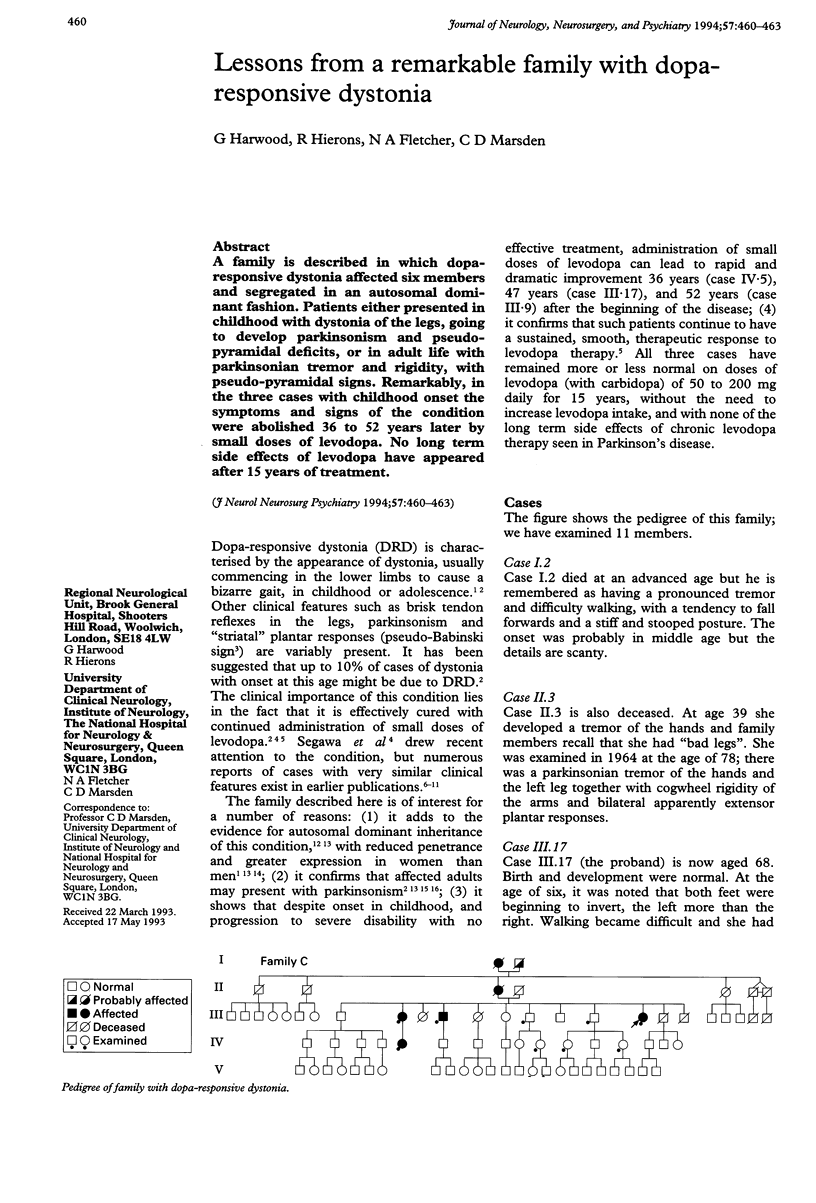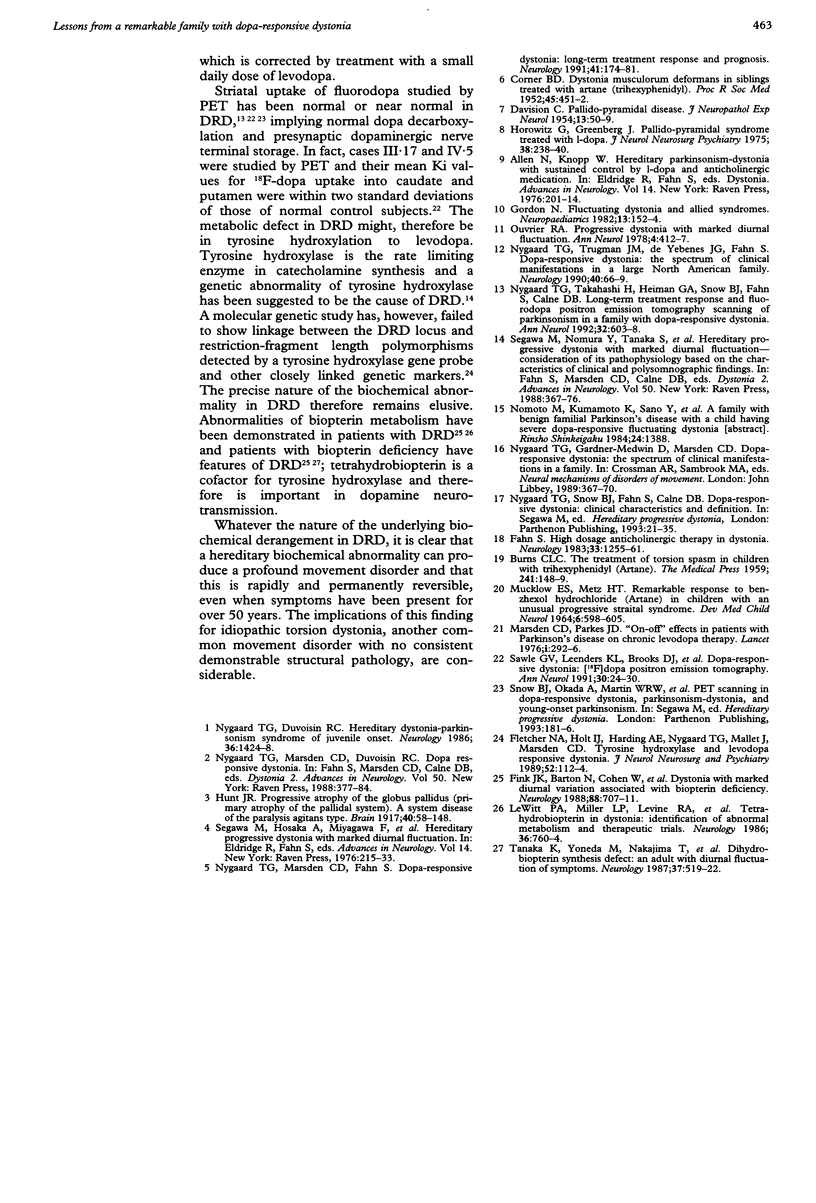Abstract
A family is described in which dopa-responsive dystonia affected six members and segregated in an autosomal dominant fashion. Patients either presented in childhood with dystonia of the legs, going to develop parkinsonism and pseudo-pyramidal deficits, or in adult life with parkinsonian tremor and rigidity, with pseudo-pyramidal signs. Remarkably, in the three cases with childhood onset the symptoms and signs of the condition were abolished 36 to 52 years later by small doses of levodopa. No long term side effects of levodopa have appeared after 15 years of treatment.
Full text
PDF



Selected References
These references are in PubMed. This may not be the complete list of references from this article.
- Allen N., Knopp W. Hereditary Parkinsonism-dystonia with sustained control by L-DOPA and anticholinergic medication. Adv Neurol. 1976;14:201–213. [PubMed] [Google Scholar]
- CORNER B. D. Dystonia musculorum deformans in siblings; treated with artane (trihexyphenidyl). Proc R Soc Med. 1952 Jul;45(7):451–452. [PMC free article] [PubMed] [Google Scholar]
- DAVISON C. Pallido-pyramidal disease. J Neuropathol Exp Neurol. 1954 Jan;13(1):50–59. doi: 10.1097/00005072-195401000-00007. [DOI] [PubMed] [Google Scholar]
- Fahn S. High dosage anticholinergic therapy in dystonia. Neurology. 1983 Oct;33(10):1255–1261. doi: 10.1212/wnl.33.10.1255. [DOI] [PubMed] [Google Scholar]
- Fink J. K., Barton N., Cohen W., Lovenberg W., Burns R. S., Hallett M. Dystonia with marked diurnal variation associated with biopterin deficiency. Neurology. 1988 May;38(5):707–711. doi: 10.1212/wnl.38.5.707. [DOI] [PubMed] [Google Scholar]
- Fletcher N. A., Holt I. J., Harding A. E., Nygaard T. G., Mallet J., Marsden C. D. Tyrosine hydroxylase and levodopa responsive dystonia. J Neurol Neurosurg Psychiatry. 1989 Jan;52(1):112–114. doi: 10.1136/jnnp.52.1.112. [DOI] [PMC free article] [PubMed] [Google Scholar]
- Gordon N. Fluctuating dystonia and allied syndromes. Neuropediatrics. 1982 Aug;13(3):152–154. doi: 10.1055/s-2008-1059614. [DOI] [PubMed] [Google Scholar]
- Horowitz G., Greenberg J. Pallido-pyramidal syndrome treated with levodopa. J Neurol Neurosurg Psychiatry. 1975 Mar;38(3):238–240. doi: 10.1136/jnnp.38.3.238. [DOI] [PMC free article] [PubMed] [Google Scholar]
- LeWitt P. A., Miller L. P., Levine R. A., Lovenberg W., Newman R. P., Papavasiliou A., Rayes A., Eldridge R., Burns R. S. Tetrahydrobiopterin in dystonia: identification of abnormal metabolism and therapeutic trials. Neurology. 1986 Jun;36(6):760–764. doi: 10.1212/wnl.36.6.760. [DOI] [PubMed] [Google Scholar]
- MUCKLOW E. S., METZ H. T. REMARKABLE RESPONSE TO BENZHEXOL HYDRO-CHLORIDE (ARTANE) IN CHILDREN WITH AN UNUSUAL PROGRESSIVE STRIATAL SYNDROME: A REPORT ON 3 CASES. Dev Med Child Neurol. 1964 Dec;6:598–605. doi: 10.1111/j.1469-8749.1964.tb02799.x. [DOI] [PubMed] [Google Scholar]
- Marsden C. D., Parkes J. D. "On-off" effects in patients with Parkinson's disease on chronic levodopa therapy. Lancet. 1976 Feb 7;1(7954):292–296. doi: 10.1016/s0140-6736(76)91416-1. [DOI] [PubMed] [Google Scholar]
- Nygaard T. G., Duvoisin R. C. Hereditary dystonia-parkinsonism syndrome of juvenile onset. Neurology. 1986 Nov;36(11):1424–1428. doi: 10.1212/wnl.36.11.1424. [DOI] [PubMed] [Google Scholar]
- Nygaard T. G., Marsden C. D., Fahn S. Dopa-responsive dystonia: long-term treatment response and prognosis. Neurology. 1991 Feb;41(2 ):174–181. doi: 10.1212/wnl.41.2_part_1.174. [DOI] [PubMed] [Google Scholar]
- Nygaard T. G., Takahashi H., Heiman G. A., Snow B. J., Fahn S., Calne D. B. Long-term treatment response and fluorodopa positron emission tomographic scanning of parkinsonism in a family with dopa-responsive dystonia. Ann Neurol. 1992 Nov;32(5):603–608. doi: 10.1002/ana.410320502. [DOI] [PubMed] [Google Scholar]
- Nygaard T. G., Trugman J. M., de Yebenes J. G., Fahn S. Dopa-responsive dystonia: the spectrum of clinical manifestations in a large North American family. Neurology. 1990 Jan;40(1):66–69. doi: 10.1212/wnl.40.1.66. [DOI] [PubMed] [Google Scholar]
- Ouvrier R. A. Progressive dystonia with marked diurnal fluctuation. Ann Neurol. 1978 Nov;4(5):412–417. doi: 10.1002/ana.410040505. [DOI] [PubMed] [Google Scholar]
- Sawle G. V., Leenders K. L., Brooks D. J., Harwood G., Lees A. J., Frackowiak R. S., Marsden C. D. Dopa-responsive dystonia: [18F]dopa positron emission tomography. Ann Neurol. 1991 Jul;30(1):24–30. doi: 10.1002/ana.410300106. [DOI] [PubMed] [Google Scholar]
- Segawa M., Hosaka A., Miyagawa F., Nomura Y., Imai H. Hereditary progressive dystonia with marked diurnal fluctuation. Adv Neurol. 1976;14:215–233. [PubMed] [Google Scholar]
- Tanaka K., Yoneda M., Nakajima T., Miyatake T., Owada M. Dihydrobiopterin synthesis defect: an adult with diurnal fluctuation of symptoms. Neurology. 1987 Mar;37(3):519–522. doi: 10.1212/wnl.37.3.519. [DOI] [PubMed] [Google Scholar]


